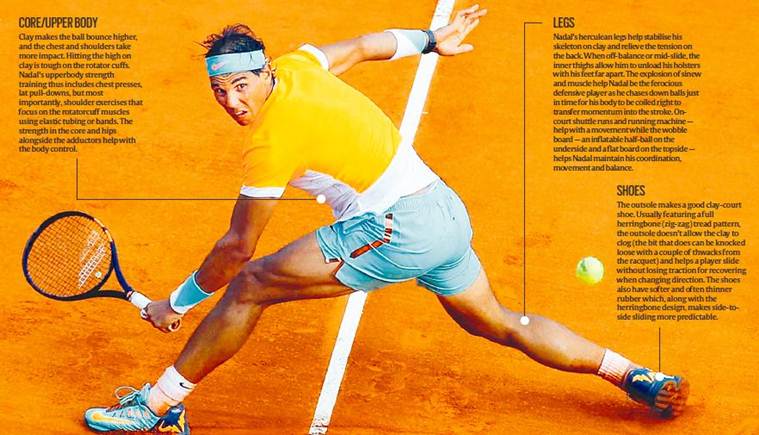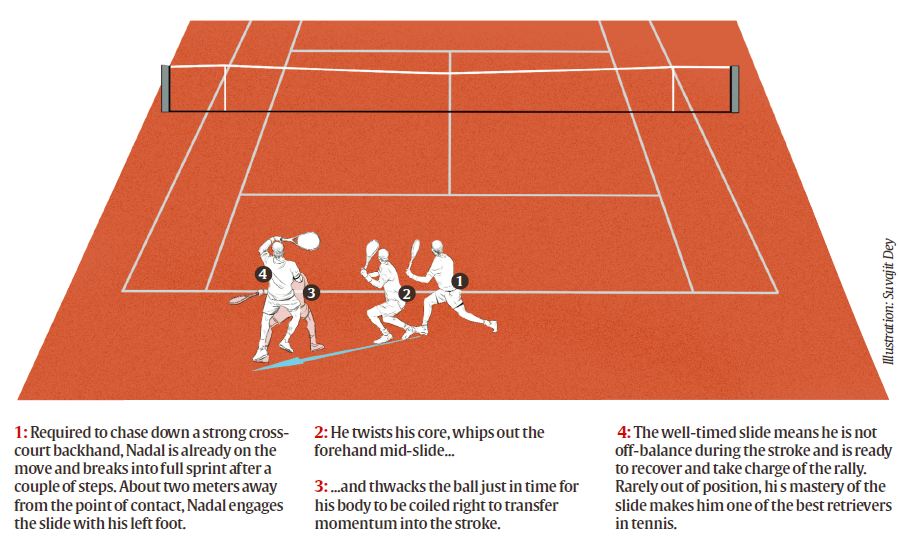
It is at Roland Garros that a tennis court doubles as a canvas, where artisans masquerading as players leave streaks of triumph and disaster on the few millimeter thin layer of red-brick dust that passes for clay. But no player has been able to impart finer strokes of technique and flair than the surface’s greatest artist, Rafael Nadal.
Inches and milliseconds separate the elite from the tennis greats. The fractions are only smaller on clay, and Nadal rules this game of fractions. The lasso of a forehand, the dizzying topspin, on-point aggression, tenacity and tactics. But the common denominator of all his strengths is his mobility and the ability to slide.
The 11-time French Open champion slides into Friday’s semifinal for a sixth contest at the Grand Slam against his arch-rival. Now, Roger Federer may not move like a GOAT on clay, but he is deceptively good with umpteen tricks to boot. Good however doesn’t cut it against Nadal, as illustrated by the five previous one-sided contests.
READ | Roger Federer hopes volley serves a win against old foe
But what makes a great slider? A lot of it comes inherently to those who grew up on the European red. Justine Henin, former world number 1 and the last pure slider women’s tennis saw, breaks it down.
“I started practicing on clay when I was younger, so it felt pretty natural to me. But I kept training that skill. A lot of foot drills, a lot of running. It was the key to my preparations,” the four-time French Open champion told The Indian Express.
“It is definitely the major part of the process of playing on clay. When you slide on clay, you cover more distance, recover quickly and can develop a lot more power into your shots.”
Being a top slider helped 5-foot-5, 125 pound-Henin grit it out with the Amazonian generation of power-hitters, marshalled by the Williams sisters.
“I had to keep moving and moving quickly to be an all-round defensive player,” says Henin. “It was integral for me to be very good on my steps, close to the ground and very strong.”
Learning to stop
It is easy on the eyes, both aesthetically pleasing and largely simple by the looks of it. Good artists have a tendency of showboating; the greats lull their audience into a false sense of security by putting up performances with consummate ease. Learning to slide is the easy part, learning when to stop makes all the difference.
“It’s a huge difference between a good player and a bad player on clay. One can be a fantastic guy on the hard court but if he doesn’t know how to slide properly you wouldn’t be able to play on clay,” says Jonas Bjorkman, former world number 4 who guided Andy Murray to his first two clay titles in 2015.
“The biggest thing is the top guys time the slide perfectly to the ball, once they are there, they stop and go back to the middle. The guys who don’t know perfect slide, they hit and continue to slide half a metre and lose a lot of time.”
Essentially, it is not about who slides the longest but the smartest. Players like Henin and Nadal are quick to anticipate the point of contact and put in several short slides, coming to a stop and transferring the momentum into the stroke. In short, you don’t have to put in long, 3-metre slides to be effective.
Federer himself alluded to his rival upon returning to the surface in three years. Speaking to the New York Times last month, Federer exaggerated — “I didn’t even remember how to slide anymore” — before sharing his thoughts on the concept.
“Sometimes the challenge for me is not to slide just to slide,” said the 37-year-old on his return to clay for the first time in three years. “I think that’s where Rafa and the top clay-courters do so well. They only slide if they really have to. Because naturally, you think, oh sliding is fun, and you start having almost too much fun. You get sucked in.”
Legs matter
Movement on clay is thus both cerebral and physical. With tree trunks for thighs, balanced pillars of sinew and thronged muscle as legs, and the back an essay in anatomical balance, Nadal is the quintessential clay-court player.
Henin explains the importance of having a strong base to succeed on clay.
“The muscles in the foot and lower leg are very important. Players on hard-court get sprains on clay because the movement is different. Because you’re always moving on hard courts. But on clay, you have to stop and then start again. It demands enormous calf and foot strength,” said Henin.
The sheer physicality helps Nadal run his opponents ragged, a reason why he wins a lot of his last sets 6-0 or 6-1. It is also the reason why 58 of his 81 titles have come on the surface. So naturally when he laments the shrinking clay season, detractors accuse him of trying to play to his strengths and maximise his chances.
“It’s obvious that I am not talking because I’m a better player on clay than on hard, because when these changes probably will happen, I will not be here around,” the 32-year-old said in 2017. “So I am talking about the benefit of the sport in general. (Clay-court) tournaments will never have a top player because the top players are always on hard… That didn’t happen in the past, when there was more tournaments on clay, that there [were] a lot of great players on clay.”
Henin reaffirms the opinion.
“Not a lot of players really do the slides well now. The clay-court season is very short. So players move in from the hard courts with not very good preparation. I always took the time to prepare, at least three weeks, for the clay season,” says Henin. “As a result, there are a lot less clay specialists now.”
Nadal, with his creaking joints and shaky form coming into Paris, thus is the last remnant of a dying art. Connoisseurs and sympathisers would do well to tune in as he goes about painting the latest tour de force.
Nadal vs Federer, 4.20pm; Live on: Star Sports Select 1/HD